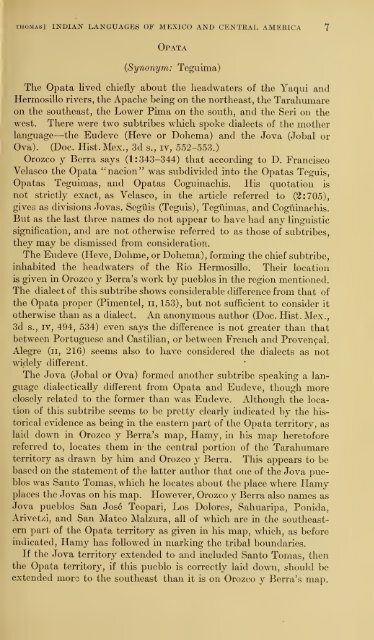Untitled - Smithsonian Institution
Untitled - Smithsonian Institution
Untitled - Smithsonian Institution
Create successful ePaper yourself
Turn your PDF publications into a flip-book with our unique Google optimized e-Paper software.
thomas] indian languages of mexico and centeal amekica 7<br />
Opata<br />
{Synonym: Tegiiima)<br />
The Opata lived chiefly about the headwaters of the Yaqui and<br />
Hermosillo rivers, the Apache being on the northeast, the Tarahumare<br />
on the southeast, the Lower Pima on the south, and the Seri on the<br />
west. There were two subtribes which spoke dialects of the mother<br />
language—the Eudeve (Heve or Dohema) and the Jova (Jobal or<br />
Ova). (Doc. Hist.Mex., 3d s., iv, 552-553.)<br />
Orozco y Berra says (1:343-344) that according to D. Francisco<br />
Velasco the Opata "nacion" was subdivided into the Opatas Teguis,<br />
Opatas Teguimas, and Opatas Coguinachis. His quotation is<br />
not strictly exact, as Velasco, in the article referred to (2:705),<br />
gives as divisions Jovas, Segiiis (Teguis), Teguimas, and Coguinachis.<br />
But as the last three names do not appear to have had any linguistic<br />
signification, and are not otherwise referred to as those of subtribes,<br />
they may be dismissed from consideration.<br />
The Eudeve (Heve, Dohme, or Dohema), forming the chief subtribe,<br />
inhabited the headwaters of the Eio Hermosillo. Their location<br />
is given in Orozco y Berra's work by pueblos in the region mentioned.<br />
The dialect of this subtribe shows considerable difference from that of<br />
the Opata proper (Pimentel, ii, 153), but not sufficient to consider it<br />
otherwise than as a dialect. An anonymous author (Doc. Hist. Mex.,<br />
3d s., IV, 494, 534) even says the difference is not greater than that<br />
between Portuguese and Castilian, or between French and Provencal.<br />
Alegre (ii, 216) seems also to have considered the dialects as not<br />
widely different.<br />
The Jova (Jobal or Ova) formed another subtribe speaking a language<br />
dialectically different from Opata and Eudeve, though more<br />
closely related to the former than was Eudeve. xilthough the loca-<br />
tion of this subtribe seems to be pretty clearly indicated by the his-<br />
torical evidence as being in the eastern part of the Opata territory, as<br />
laid down in Orozco y Berra's map, Hamy, in his map heretofore<br />
referred to, locates them in the central portion of the Tarahumare<br />
territory as drawn by him and Orozco y Berra. This appears to be<br />
based on the statement of the latter author that one of the Jova pueblos<br />
was Santo Tomas, which he locates about the place where Hamy<br />
places the Jovas on his map. However, Orozco y Berra also names as<br />
Jova pueblos San Jose Teopari, Los Dolores, wSahuaripa, Ponida,<br />
Arivetzi, and San Mateo Malzura, all of which are in the southeast-<br />
ern part of the Opata territory as given in his map, which, as before<br />
indicated, Hamy has followed in marking the tribal boundaries.<br />
If the Jova territory extended to and included Santo Tomas, then<br />
the Opata territory, if this pueblo is correctly laid down, should be<br />
extended moro to the southeast than it is on Oroz(io y Berra's map.

















